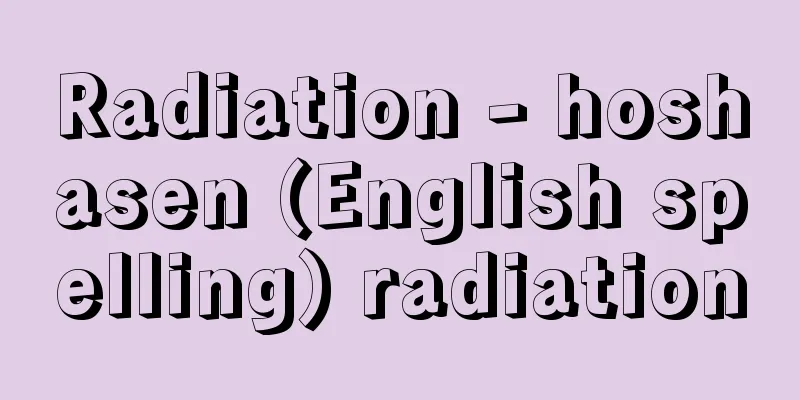Radiation - hoshasen (English spelling) radiation

|
The particle beam emitted as a result of the decay of a radioisotope is called radiation (the property of emitting radiation is called radioactivity), but in a broader sense it includes particle beams such as elementary particles and charged heavy particles, as well as X-rays, which are photons. Three types of radiation are emitted during decay: α (alpha) particles, β (beta) particles, and γ (gamma) rays. α particles are helium nuclei, β particles are electrons, and γ particles are photons and electromagnetic waves with very short wavelengths, all of which ionize gases and solids. α particles are particles with strong ionizing properties, and depending on their energy, they are absorbed by a few centimetres of air. β particles can penetrate a few millimetres of aluminium, and γ rays can penetrate a few centimetres of lead. [Jun Sakurai] Effects of radiation and permissible doseRadiation exposure is a problem at nuclear facilities and nuclear power plants, and most of it is caused by gamma and beta rays. The amount of radiation to which humans are exposed is expressed in units of sieverts (Sv). Originally, X-rays were expressed in units of roentgens, which are defined as the amount of X-rays that produce one electrostatic unit of ions in one cubic centimeter of air under standard conditions. Since damage is caused not only by X-rays but also by all other types of radiation, the amount of radiation that produces the same physical effect as one roentgen of X-rays is calculated, and the dose measured in units of this is called the sievert. The effects of radiation on living organisms vary depending on the type and particle energy. When a substance is irradiated with radiation, the most significant change that the substance undergoes is ionization, in which electrons in atoms are kicked off by the radiation and ions are created. Since damage to living organisms is also thought to be caused by this ionization, the definition of dose is based on this. Around 1930, when X-ray diagnosis began to spread, a specialist organization issued the first international recommendation on the permissible X-ray dose, which was 0.2 roentgens per day. As international discussions arose about further lowering the permissible dose, the United States decided in 1972 to set the environmental standard for nuclear power plants at 0.05 millisieverts per year around the site and 0.01 millisieverts per year on average for the population. Following suit, the Japanese Atomic Energy Commission decided in 1975 to set the target dose around nuclear power plants at 0.05 millisieverts per year. Most people die when exposed to a total body dose of 6 sieverts or more. At 5 sieverts, death is common even with the careful care of a hospital. However, at 1 sievert or less, there are almost no subjective symptoms. And at 0.25 sieverts or less, no abnormalities can be detected by normal clinical tests such as blood tests. However, even if acute damage does not occur, radiation damage never goes to zero, even at low doses, and it has become clear that the risk of genetic and late-onset damage remains. The horror of radiation and the difficulty of preventing damage became apparent, and a history of lowering the permissible dose began. In Japan, the maximum permissible radiation dose is currently set by law. This was decided based on international recommendations from 1977, and the maximum permissible dose for professionals is 50 millisieverts per year, and for the general public it is one-fiftieth of that. Professionals are people who work in workplaces that handle radiation, and for their safety, they are required to measure the amount of radiation they are exposed to and undergo regular health checks, and sufficient protective measures and shielded environments are in place. In addition, when using medical radiation and for examinations such as X-rays, sufficient protective measures, safety measures and standards are in place for not only professionals but also patients, test subjects and other related parties. [Jun Sakurai] Radiation ProtectionIn nuclear facilities and nuclear power plants, various shielding designs are used to keep radiation exposure as low as possible. In addition, radiation levels in the facilities are constantly checked, and radiation management is meticulously performed. People who work in radiation environments can wear film badges, film rings, pocket chambers, alarm meters, etc. to keep track of their whole-body and localized radiation exposure doses. Film badges are the most common way to measure radiation exposure doses. A badge containing a special film is attached to a pocket of clothing, and by developing it at regular intervals, the total radiation dose a person has been exposed to can be determined from the degree of blackening. Film rings are film badges shaped like rings, and are intended to measure radiation exposure doses, especially of the hands. Pocket chambers are dosimeters that have an ion chamber the size of a fountain pen, making them easy to carry. They are charged before use, and the radiation exposure dose can be read directly from the amount of discharge caused by radiation after a certain period of time. Unlike film badges and film rings, pocket chambers allow the radiation exposure dose to be read directly at any location. Alarm meters are designed to sound an alarm when the radiation exposure reaches a set value, and are used when working in areas of high radiation levels within nuclear power plants. Hand and foot monitors are permanently installed at the entrances and exits of controlled areas, allowing workers to check for radioactive contamination of the hands and feet. After a set period of measurement, the presence or absence of contamination is displayed, and the alarm setting is generally set to the radiation level of fallout (radioactive material that falls to the ground). It can be said that a highly sensitive detection method is used. [Jun Sakurai] Radiation Detection MethodsMethods for detecting radiation vary depending on the type of radiation, but the most common and easiest method is to detect gamma rays. Germanium semiconductor detectors are widely used as gamma ray detectors, and are used in combination with pulse height analyzers for nuclide analysis and absolute measurement of radioactivity. This detector uses the ionization effect of gamma rays in solids, and has a resolution of about 2 kiloelectron volts for 1 megaelectron volt gamma rays. The standard measurement system is a combination of this detector, a signal amplifier, and an 8000-channel pulse height analyzer (usually called a pulse height analyzer). When there is a large amount of measurement data, a computer is used instead of a pulse height analyzer to streamline the work. [Jun Sakurai] [References] | | | | | | | | | |©Shogakukan "> Types and characteristics of radiation Source: Shogakukan Encyclopedia Nipponica About Encyclopedia Nipponica Information | Legend |
|
ラジオ・アイソトープ(放射性同位体)の崩壊に伴って放出される粒子線を放射線という(放射線が放出される性質を放射能という)が、広義には素粒子や荷電重粒子などの粒子線を含み、光子であるX線も含まれる。 崩壊に伴って放出される放射線は、α(アルファ)線、β(ベータ)線、γ(ガンマ)線の3種である。α線はヘリウムの原子核、β線は電子、γ線は光子でもあり非常に波長の短い電磁波でもあり、いずれも気体や固体を電離する。α線は強い電離作用をもった粒子で、そのエネルギーによって異なるが、数センチメートルの空気で吸収されてしまう。β線は厚さ数ミリメートルのアルミニウムを、またγ線は厚さ数センチメートルの鉛をも貫通する。 [桜井 淳] 放射線の影響と許容線量原子力施設や原子力発電所では放射線被曝(ひばく)が問題となるが、その大部分はγ線とβ線に原因している。人間が被曝した放射線の量はシーベルトSvを単位として表されている。もともとX線はレントゲンを単位として表されており、それは1立方センチメートルの標準状態の空気中に1静電単位のイオンを生じるだけのX線の量と定義されている。障害を生じるのはX線だけでなく、ほかのあらゆる種類の放射線にも共通するため、1レントゲンのX線と同等の物理的効果を生じる放射線の量を求め、それを単位として測った線量をシーベルトということにしている。放射線はその種類によっても、また粒子エネルギーによっても、それぞれ生物体に与える影響はさまざまである。物質に放射線が照射されるとき、物質の受けるもっとも著しい変化は、原子内の電子が放射線によって跳ねとばされてイオンがつくられる電離作用である。生物体の障害もこの電離作用が原因と考えられるので、線量の定義もこれを基礎にして組み立てている。 X線による診断が普及し始めた1930年ごろ、X線の許容線量の国際勧告が専門機関によって初めて出されたが、そのときの値は1日に0.2レントゲンであった。許容線量をさらに切り下げるべきだという議論が国際的におこったため、アメリカでは原子力発電所の環境基準として、敷地周辺において1年に0.05ミリシーベルト以下、人口大集団での平均では0.01ミリシーベルト以下にすることを1972年に決めた。日本の原子力委員会もそれに倣って1975年(昭和50)に原子力発電所周辺の線量目標値を1年に0.05ミリシーベルトとすることを決定した。人間は6シーベルト以上の線量を全身に浴びると、ほとんどの場合死亡する。5シーベルトだと、病院の手厚い看護を受けても死亡する場合が少なくない。ところが1シーベルト以下だと、ほとんど自覚症状も出ない。そして0.25シーベルト以下であると、血液検査など通常の臨床検査では異常を認めることができない。しかし、急性障害はおこらなくても、低い線量でも放射線障害は決してゼロにはならず、遺伝障害や晩発性障害のリスクが残ることが明らかになってきた。放射線の恐ろしさ、障害防止のむずかしさが認識され、許容線量の切り下げの歴史が始まった。 日本では現在、放射線の許容線量は法令によって定められている。1977年の国際勧告をもとに決められたもので、職業人に対しては1年に50ミリシーベルト、一般人にはその50分の1を最大許容量としている。職業人とは放射線を扱う職場で働く人で、彼らの安全のため、個人の被曝する放射線量の測定と定期的な健康診断を義務づけ、十分な防護措置や遮蔽(しゃへい)環境などが設けられている。また、医療用放射線の使用、X線撮影などの検査等に際しても、職業人はもちろん、患者・被験者など関係者のための十分な防護措置、安全対策と基準が設けられている。 [桜井 淳] 放射線防護原子力施設や原子力発電所では、放射線被曝をできるだけ低く抑えるために、種々の遮蔽設計が施されている。さらに、施設内の放射線レベルは絶えずチェックされ、放射線管理には細心の注意が払われている。放射線環境下で働く人々は、フィルムバッジ、フィルムリング、ポケットチェンバー、アラームメーターなどを身につけ、全身および局部的な被曝線量をつねに知ることができる。フィルムバッジは被曝線量を測定するもっとも一般的な方法であり、特殊フィルムを収めたバッジを衣服のポケットなどにつけておき、一定期間ごとに現像処理することにより、その黒化度からその人が被曝した全線量を知ることができる。フィルムリングは、フィルムバッジを指輪形にし、とくに手先の被曝線量を測定することを目的にしている。ポケットチェンバーは、イオンチェンバーを万年筆程度の大きさにし、携帯に便利なようにした線量計である。使用前に帯電させておき、一定時間後に放射線によっておこった放電量から被曝線量を直読できる仕組みになっている。ポケットチェンバーは、フィルムバッジやフィルムリングと異なり、いかなる場所でもすぐに被曝線量を直読することができる。アラームメーターは、被曝量が設定値に達したときアラームを発する仕組みになっており、原子力発電所内の放射線レベルの高い場所で作業する場合に用いられる。管理区域の出入口にはハンドフットモニターが常設されており、手足の放射能汚染を調べることができる。一定時間の計測後、汚染の有無が表示されるが、アラーム設定値はフォールアウト(地表に降ってくる放射性降下物)の放射能レベルにしてあるのが一般的である。非常に感度のよい検出法が適用されているといってよい。 [桜井 淳] 放射線検出法放射線の検出法は、放射線の種類によって異なるが、もっとも一般的でしかも容易なのがγ線の検出法である。γ線検出器として広く利用されているのはゲルマニウム半導体検出器であり、波高分析器と組み合わせて核種分析、放射能の絶対測定などに用いられている。この検出器は、γ線の固体中での電離作用を利用したもので、その分解能は1メガ電子ボルトのγ線に対して約2キロ電子ボルトである。この検出器と信号増幅系、8000チャンネル波高分析器(パルスハイト・アナライザー。通常パルハイとよばれている)を組み合わせたものが標準的な測定系とされている。測定データが多い場合は、波高分析器のかわりにコンピュータが利用され、作業の能率化が図られている。 [桜井 淳] [参照項目] | | | | | | | | | |©Shogakukan"> 放射線の種類と特性 出典 小学館 日本大百科全書(ニッポニカ)日本大百科全書(ニッポニカ)について 情報 | 凡例 |
Recommend
Japanese lacquer (English spelling)
… Lacquer, although of poor quality, is extracted...
Uranium transformation process - Uranium epilepsy
…For this purpose, the refined uranium concentrat...
Siberian bighorn (English spelling)
…Also called bighorn sheep, it is a sheep with la...
Ibero-Romance languages - Ibero-Romansugu
...In the case of languages that have developed...
Apex beat - apex beat
A protuberance on the chest wall that occurs when ...
Duiker - Daikar (English spelling) duiker
A general term for animals in the genus Duiker, o...
House dog - House dog
…A mammal of the family Canidae in the order Carn...
Color fastness - Senshokukenroudo
The degree of fastness of dyes to various external...
Saône [river] - Saône
A tributary of the Rhône in eastern France. It ori...
Hydroclathrus clathratus (English spelling)
...In other words, generations change between the...
Electrostatic precipitation
Dust collection using the action of electricity is...
Climate science - climatology
The science that studies climate. As is clear fro...
Pagoda (English spelling)
In the narrow sense, it refers to pagodas or tower...
Ukko
…The forest god Tapio manages the hunters' ca...
National Popular Theatre (TNP)
One of France's national theater companies. It...









